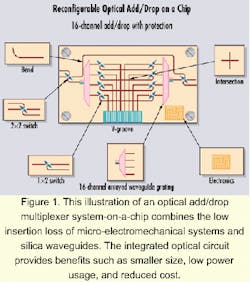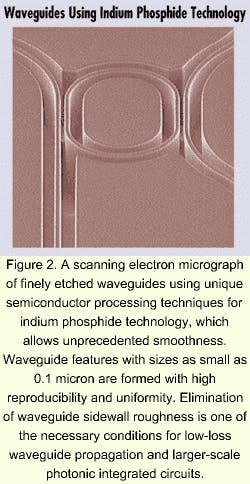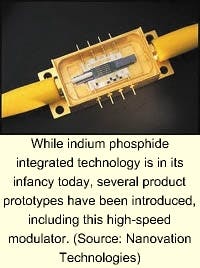Optical-switching technologies: off-the-shelf or custom-integrated?
The success of all-optical DWDM systems rests on making informed decisions about component technologies and their suppliers.
Dr. Gary C. Bjorklund
Nanovation Technologies
As communications pro viders bring fiber closer to the home and workplace, the future use of all-optical switching within DWDM is virtually assured. The only question remaining is how to bring this technology into the network quickly and cost-effectively while leaving room for innovations.
Since no two DWDM systems are absolutely identical in design and functionality, selecting components from off-the-shelf technology could present problems for retrofitting existing solutions. The future presents even greater challenges. Without the availability of inexpensive custom optical components, manufacturers are left with little flexibility in designing next-generation systems.
Component vendors are seizing this opportunity to introduce inventive and diverse technologies into the marketplace. With seemingly divergent technology paths such as indium phosphide (InP) circuits to micro-electromechanical systems (MEMS), choices are not clear-cut.
The key to a successful all-optical DWDM product line rests on selecting the right component technologies for current systems while ensuring a logical migration path for future products. With the rapid emergence of new players in the optical industry, manufacturers must study all the options before selecting a technology or vendor to provide it.
The foremost issue in selecting components for a DWDM system is choosing the right kind of optical technology. From off-the-shelf systems to boxes with custom-integrated components, the network designer must find the technology that offers the best potential for the future. Therefore, equipment manufacturers will need to have long-range strategic development plans in place to make appropriate evaluations.For those companies willing to move forward with cutting-edge technology, the potential rewards are tremendous. In addition to earning a reputation for innovation, these manufacturers may have an opportunity to dictate platform standards.
But such a bold initiative is not without risk. Rapid development and early adoption of new DWDM component technologies could have a high price. If the decision is wrong, the company will pay dearly in time and money as it learns and recovers from its mistakes. Those afraid to innovate can always wait to see what technologies competitors adopt, but by then, it could be too late.
In general, off-the-shelf components are best suited to systems that are constructed using discrete fiber-pigtailed optical components such as individual lasers, detectors, optical switches, splitters, taps, variable attenuators, and multiplexers/demultiplexers.
The unique design of these systems stems from the topology in which the components are connected to form the system. To achieve gains in price, performance, density, and reliability, future systems will increasingly incorporate integrated components. These integrated components, which form the basis of a generic optical DWDM switching system, will provide functions previously performed by groups of discrete components.Examples of integrated components composed of identical subcomponents include switch matrices, linear arrays of 1x2 or 2x2 switches, and linear arrays of splitters. Integrated components consisting of different types of subcomponents include lasers with modulators, multiplexers/demultiplexers with arrays of 1x2 switches, switch arrays with splitters and taps, and laser arrays with switches. Some of these integrated components, particularly those consisting of identical subcomponents, will be off-the-shelf products. The systems consisting of different types of subcomponents will increasingly consist of customized components that capture elements of a system's unique design topology.
To evaluate the off-the-shelf potential of all-optical technologies for DWDM systems, the network designer first must determine whether the particular technology used to build generic switches or other components truly lends itself to readily scalable, advanced manufacturing methods. Components that are easily manufactured offer room for continuous improvements in price, performance, reliability, uniformity, and volume availability-all critical factors in technology selection.
Advanced manufacturing methods include automated pick-and-place assembly and lithographically defined planar processing. For example, consider DWDM multiplexers/demultiplexers. There are several technology choices for these components. High performance can be achieved by using either dielectric thin-film-coating technology or planar optical-waveguide technology.
DWDM multiplexers/demultiplexers based on dielectric thin films are currently hand-assembled or hand-aligned. Any increase in manufacturing capacity requires a linear expansion of plant space and manufacturing manpower. As capacity increases, it is difficult to maintain uniformity and reliability standards.
In contrast, the arrayed-waveguide-grating (AWG) multiplexers/demultiplexers are produced using optical lithography and semiconductor processing techniques. Higher manufacturing capacity can be achieved with sub-linear increases in plant space and manpower. There is a clear path to achieving higher uniformity and reliability using successively more powerful generations of lithography and semiconductor processing equipment, thus satisfying the requirements for price, performance, reliability, uniformity, and volume availability.
While generic off-the-shelf components fulfill certain needs, these devices lack the potential that full-scale custom integration offers for components built using the same advanced fabrication techniques. For example, functionality for specific applications such as long-haul or metro networks can be created with near plug-and-play ease.
Custom integration is necessary for system designs that require individual optical components arranged in a unique topology. It isn't required for systems that incorporate individual components in uniform or standard topologies. These optical components, such as 4x4 or 8x8 switch matrices, will become standard integrated products.
Appropriate materials selection is the foundation of any integrated optical solution because it is vital in ensuring component compatibility. The overall system design must be segmented into device groupings that are compatible with the materials system chosen for the integrated components. The reason is that certain device functions can be more easily achieved than others for a particular materials system.
For example, if the lowest possible insertion loss is required, the silica-on-silicon materials system is the best choice (see Figure 1). A popular method of switching in silica waveguides, albeit an energy-consuming one, is the thermo-optic approach using Mach-Zehnder interferometer or modal evaluation structures. Higher-contrast, lower-power-dissipation switching can be achieved using hybrid integration of MEMS actuated mirror devices. For both switching technologies, switching speeds will be limited to milliseconds or longer.
The high-speed properties of lithium niobate, commercially available for some time, make it a near-term solution for medium-scale switch arrays and multigigabit-per-second modulators. Hybrid attachment is sometimes used to incorporate active devices such as pumped lasers, pumped amplifiers, and photodetectors, although there is considerable difficulty in matching the optical mode sizes.These high-speed devices can also be implemented in InP materials systems (see Figure 2). Gigabit-per-second modulators and high-speed switching in a nanosecond or less can be attained using the electro-optic or Franz-Keldysh effects in Mach-Zehnder interferometer or Y-branch modal-evolution structures (see photo). And wavelength selective switching can be achieved in unbalanced Mach-Zehnder structures.
While cost is always an issue, it is not necessarily the first factor to consider when selecting a component vendor. A technology road map that complements the manufacturer's product line and lends itself to the planned migration path to next-generation systems is critical. If the equipment manufacturer is willing to become an early adopter of cutting-edge technology, then the vendor must be equally committed.
Another key issue is whether the vendor can meet the manufacturer's functionality and performance requirements cost-effectively and in volume. Component technologies must be compatible with the manufacturer's existing systems and offer the versatility to scale up or down to meet the requirements of new DWDM applications such as short-haul metro systems. In addition, the component vendor must have the expertise and agility to use both traditional and nontraditional means to achieve integration success. The ability to integrate multiple functions in a single integrated component can lead to smaller, more economical DWDM equipment boxes.
To remain competitive, equipment manufacturers can't afford the time or expense to completely re-engineer systems for every possible application. Therefore, chosen component vendors must have the ability to fabricate custom-integrated components quickly, economically, and in volume so that existing products lines don't have to be re-engineered.
The fabrication, of course, usually begins with design. The expertise necessary to design custom-integrated components varies from manufacturer to manufacturer. But it shouldn't vary from within the vendor. A reliable vendor will provide the in-house support and expertise necessary to design custom-integrated components with the desired features and functionality. Vendors should also provide appropriate software tools that will enable equipment manufacturers to internally design and test integrated component ideas.
The ability to design new systems and integrate multiple functions on a single integrated component escalates in importance as new materials emerge. The component vendor must keep pace with the advancements to provide a complete suite of solutions. For example, silica-on-silicon is a popular material for integrated subsystems, yet InP has even greater promises for DWDM applications in the future (see Figure 2).
The most overlooked characteristic of a vendor is its relationship to academic research centers. To remain competitive and on the cutting edge, vendors must have access to the best and brightest academic research facilities. Forward-thinking component vendors are often first to apply the results of academic research to commercial application. The first-to-market opportunity is passed on to systems customers who can become early adopters of new technologies.
For DWDM to reach its full potential, more technology is required than simply packing additional wavelengths down a single strand of fiber. It is also necessary to develop better equipment for switching and manipulating the various wavelengths after the signal emerges from the optical "pipe." This means carefully selecting the optical-component technology that will best meet immediate needs with a solid migration path for the future.
Dr. Gary C. Bjorklund is chief technology officer and senior vice president at Nanovation Technologies (Miami).



